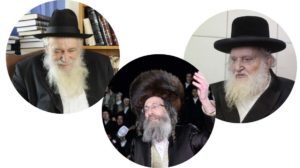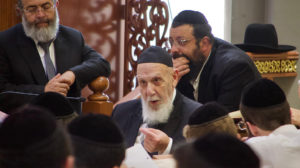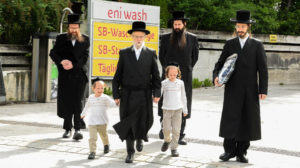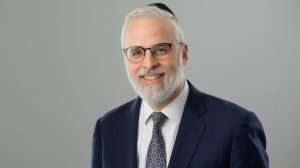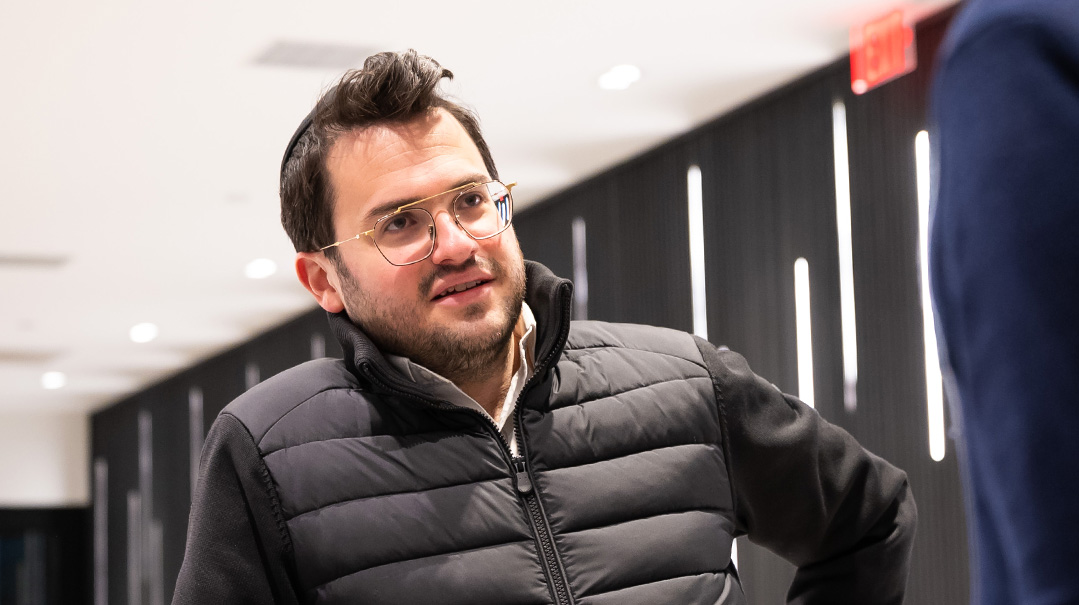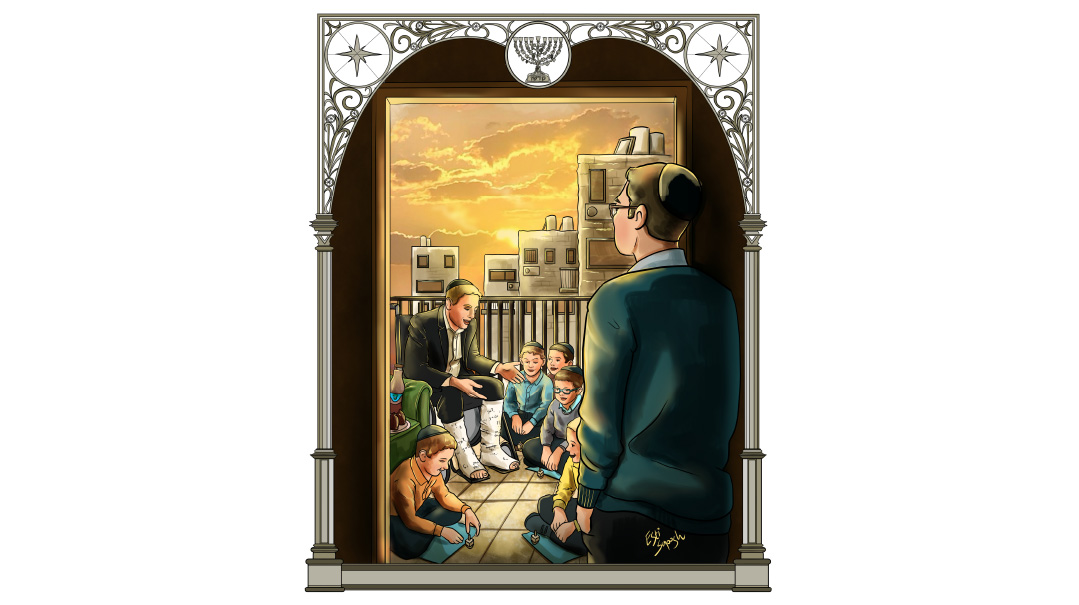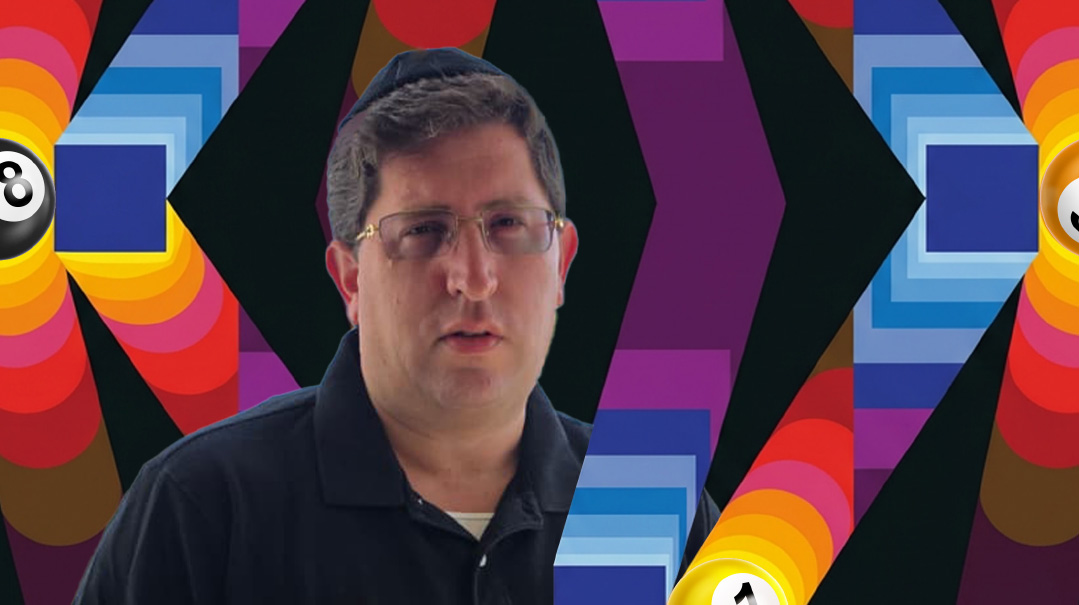What Love Can Do

Rav Yitzchak Dovid Grossman reflects on half a century of miracles in this turned-around development town
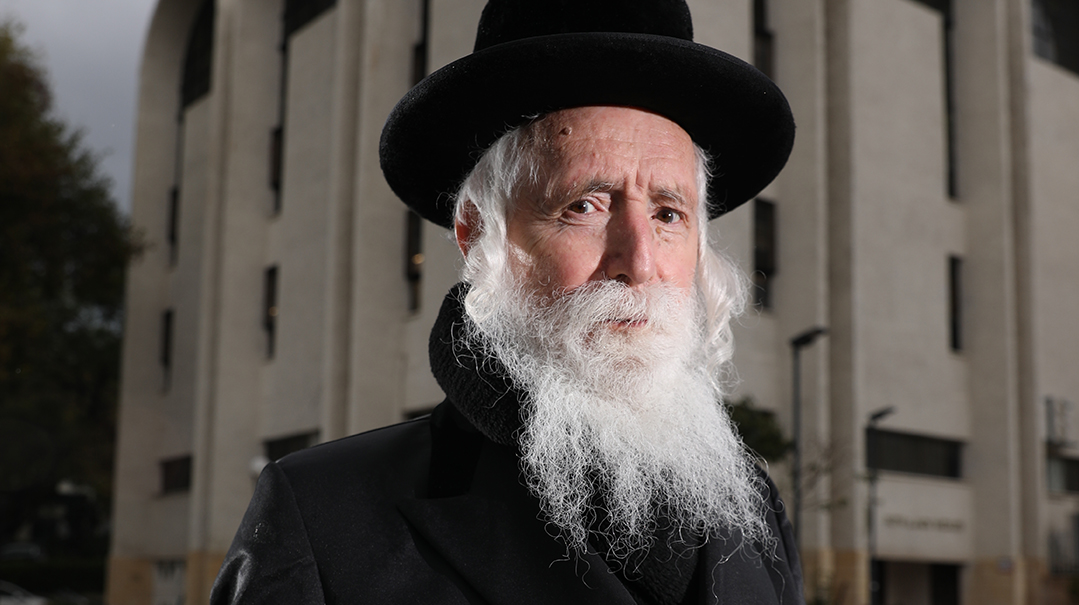
Photos: Menachem Kalish, ArtScroll
Whatever you’ve heard about Israeli development towns is probably unpleasant. Thrown together with no foresight to house teeming groups of Jewish refugees from Arab lands, these 1950s-era outgrowths of the ma’abarot featured Second World construction, inadequate utilities, few services, no amenities, and little prospect for escape. Unemployed men loitered in town squares, and the musty, dusty streets were too dangerous to walk at night.
Migdal Ha’emek, in the center of the Lower Galilee, was probably the most notorious of these towns, the poster child of the gritty immigrant cities in the 1950s and ’60s.
Enter the town today, though, and you’ll see something more like a tidy inner-ring suburb: solidly middle-class, well-maintained modest houses in neat yards, thriving shops and businesses. An entire section of the town is given over to a large, landscaped educational campus.
As we arrive at the modern, well-appointed head office of Migdal Ohr Institutions, the mayor of Migdal Ha’emek, Eli Barda, is taking leave of his host, Rav Yitzchak Dovid Grossman.
The mayor’s bearing is all deference and respect as he and his staff back out of the office. Rav Grossman blesses the mayor with heartfelt wishes for success, which Barda accepts gratefully.
Eli Barda is himself a product of Rav Grossman’s transformation of this northern outpost. As a child, Barda participated in an after-school Torah program organized by the kollel avreichim Rav Grossman had brought to town some five decades ago. During a Chanukah learning program, young Eli performed well enough on a test to earn a prize he still treasures today: a book about Eliyahu Hanavi.
The contrast between the tableau that has just played out in Rav Grossman’s office and the suspicion that greeted him upon his first arrival in Migdal Ha’emek in 1968 couldn’t be more stark.
“At the beginning, when I first got here, the mayor and the town elders thought I had been sent here to recruit for the Agudas Yisrael political party,” he says. “They couldn’t believe I had come here strictly to spread Yiddishkeit. So naturally they made problems for me. Ultimately they realized this wasn’t about politics — I only wanted neshamos.”
Rav Grossman seats his guests at the broad conference table in his office, the walls of which are lined with photo after photo of groups of students of all ages. The occasion for this conversation is ArtScroll’s release this week of Living Legend: Rav Grossman of Migdal Ha’emek, by noted storyteller Rabbi Nachman Seltzer, cataloguing 50 years’ worth of stories about Rav Grossman’s life and career.
For Rav Grossman, it offers an opportunity to reflect on the worlds that have been built over the last half century and to apply some of the lessons he’s learned to solving the conundrums facing the Torah community today.
Gratitude into Action
Rav Grossman, who first entered the Israeli public consciousness around 1970, is a sixth-generation Yerushalmi, born in 1946 to the noted posek, dayan, and rosh yeshivah Rav Yisroel Grossman ztz”l. He grew up in Meah Shearim and formed a close connection to the Lelover Rebbe, Rav Moshe Mordechai Biderman ztz”l, who always called him by his childhood nickname, “Itche Duvid.”
He has always remained steadfast in his family’s chassidic traditions, but from an early age, he recounts, he was drawn toward a certain segment of Klal Yisrael.
“Already from the age of 16 I felt a strong pull to work with Sephardi youth,” he says. “If you know Jerusalem a little bit, between Meah Shearim and the Old City is an area called Musrara — it was a very, very rough neighborhood. That’s where the ‘Black Panthers’ Mizrahi protesters grew up — Charlie Biton, and all the leadership of that group. I felt drawn there. I would go there and speak with people.”
Rav Grossman recalls with amusement that in 2004, when he was awarded the Israel Prize (the highest civilian honor awarded by the state), a TV channel filmed a documentary about him, even going so far as to track down old acquaintances in Musrara who fondly remembered the chassidishe bochur.
“Some of the regulars at Beit Knesset Eliyahu Hanavi in Musrara told the reporter, ‘That vuz-vuz [a derogatory description for an Ashkenazi Jew] used to come around here all the time,’” he says.
If the Sephardi population exerted a pull on young Itche Duvid, then it was a historical event that gave him a push.
In the days leading up to the Six Day War in 1967, a sickening dread had settled over the entire Jewish population, as Arab armies massed on Israel’s borders. Enemy radio broadcasts promised complete annihilation. When the Jewish state scored miraculous victories over the invading forces and was able to seize control of the Old City of Jerusalem, panic turned to elation. With all this coming just before Shavuos, the army decided to open access to the Kosel Hamaaravi for the Yom Tov.
“You have to understand — I grew up in Jerusalem, and from the time I was a small child, I dreamed of going to the Kosel,” Rav Grossman relates. “There was a Jew named Reb Shimon Rubin from the Old City who knew every stone of Jerusalem. When I was 15, I went up to Reb Shimon Rubin and asked, ‘Maybe you can work out a plan for me — if I jump from a wall in the Kishle [where the police station in the Armenian Quarter is now] in Migdal Dovid, through Har Tzion, how can I sneak in to the Kosel to touch its stones?’
“That was my fantasy then,” he continues emotionally, even after the passage of decades. “And here, now, the fantasy was being realized.”
He describes the epiphany he felt standing before the Wall, the turnabout from terror to euphoria, seeing in it a paradigm for Mashiach’s arrival.
“I was standing at the Kosel, talking to HaKadosh Baruch Hu — ‘Ribbono shel Olam, how can I thank You? For ten days we were all consumed by panic that we wouldn’t be left alive, and here we are at the Kosel.’” He felt obliged to turn his gratitude into action.
“I said to myself I would leave Jerusalem and dedicate myself as a korban, for one year, in a place where life is hard.”
Disco Rabbi
Armed with this resolve, young Rav Grossman sought the advice of his mentor, the Lelover Rebbe. The Rebbe answered his talmid: “Itche Duvid, efsher vest di arupgain a kik tun vus di kenst eppes oiftun in Migdal Ha’emek — Maybe you’ll go down and see what you can get done in Migdal Ha’emek?”
“I had never heard of Migdal Ha’emek in my life,” Rav Grossman admits. “I had no clue whether it was in the north or the south. But that’s what the Rebbe said to do.”
Finding out that the development town in the Lower Galilee was known mainly for its crime and intense social problems was not enough to make him reconsider his rebbe’s advice. He had only to secure agreement from one other party — his young wife, Esther. (Their three-month-old daughter could not yet voice her opinion.) Here too it seemed that Hashem had already cleared the way for him.
“My wife’s father was Rav Berish Rosenberg, a mashpia of the Chabad community in Lod [her brother is Rabbi Shimon Rosenberg, father of Rivkie Holzberg Hy”d] and she grew up with the concept that if the Rebbe says something, you need to listen,” Rav Grossman explains. Then he chuckles. “If my wife had been a Yerushalmi, like my brothers, hayta mareh li et haderech — she would have set me straight.”
The young couple agreed that Yitzchak Dovid should go reconnoiter the town in advance of their moving there. Built in 1953 to accommodate the incoming waves of Sephardi olim from North Africa, Migdal Ha’emek in those days was a poverty-stricken, crime-infested backwater. The immigrants faced discrimination and scarce employment prospects, and social dysfunction took hold.
So the tall, young chassidic rabbi who stepped off the bus from Jerusalem (by way of Tel Aviv, Haifa, and Nazareth), definitely stood out. He stopped a shocked passerby and asked where he could find the young people.
“When I entered the town here, I was still very naive, straight from Meah Shearim, where every second building is a yeshivah, kollel, or Talmud Torah,” he says. “I asked someone on the street, ‘Where is the yeshivah here?’ He looked at me uncomprehendingly. ‘Kollel? Talmud Torah?’ I wasn’t getting anywhere, so I asked, ‘Where are the youth?’
“He answered, ‘They’re in the discotheque.’
“I had never in my life heard the term ‘discotheque.’ I thought maybe it was a kind of yeshivah called a ‘discotheque.’ I asked him how to get there, and he told me. I entered the discotheque, and they were all in shock. Here stood a young rabbi, long beard, black hat, black coat. They were sure someone had been niftar, and I was looking for a minyan to say Kaddish.”
You Want to be Ready
“I was in shock,” he remembers, “but ironically, so were the 45 kids in the room. A rabbi with a chassidishe fur hat, a long coat, and a beard had just entered their world of the disco. They stared at me with bulging eyes.
“Some of the brighter ones assumed I was searching for a minyan so aveilim could recite the Kaddish. When I reassured them that I wasn’t in search of a minyan, they were completely at a loss.”
“So what are you looking for then?” they asked the strange figure.
The next line was delivered with the trademark Grossman tendency to say the right line at the right moment. It would happen numerous times over the decades.
“I’m from Yerushalayim, but I want to come live here.”
The teenagers stared at the rabbi with the long beard. He could see the same look in each of their eyes. This man is crazy!
“You want to move here?! We all dream of escaping this place and moving to Tel Aviv or Yerushalayim, and you want to come here?!”
“Our nation just experienced such incredible miracles,” he told them. “Look, the Kosel is back in our hands; Mashiach can’t be far away! And all of you here are my brothers. What do you think, that just because you come from Morocco and my family comes from Eastern Europe, we are a different people? I came here because I want to teach you what it means to be a Jew, so that when Mashiach walks through the door, you’ll be ready for him.”
Rav Grossman had already been working with the kids in Chinuch Atzmai for a year by that time and he knew the lingo. He knew all about Morocco, the cities their grandparents had lived in, their heritage and their traditions. He knew what spoke to their hearts and souls. But they didn’t know that he knew, and they couldn’t believe what they were hearing.
“I still can’t fully explain how the miracle happened,” the rabbi said. “There’s no explanation to the instant spiritual connection that sprang up between me and the youth of Migdal HaEmek….”
—excerpted from Living Legend, ArtScroll/Mesorah Publications
Dubbed by the secular media “the Disco Rabbi,” brief clips can still be found showing a much younger Rav Grossman, tall and thin, looking every bit the recent transplant from Meah Shearim, speaking earnestly through the cigarette smoke, over the blaring music, to the young Sephardi patrons crowding around him, shaking their hands, listening, connecting.
“From the first moment, I felt like there was a magnetic force between us,” he says now. “They set me up in a corner, and I began to speak with them.”
Until today, Rav Grossman hasn’t shed a trace of his Meah Shearim upbringing, yet he somehow looks less like a transplant. Perhaps it’s because now he belongs everywhere, to everyone.
Every Child Counts
We’re interrupted by Rav Grossman’s assistant Yossi, who’s brought three young graduates of the Migdal Ohr high school to receive brachos. Two of the boys are commencing army service, and the other is continuing on to yeshivah.
Rav Grossman instantly focuses on the three, asking the army-bound boys which units they will be serving in, where they will be stationed. He queries the third about his yeshivah, tells him something about the rebbeim there. He showers them all with heartfelt brachos for success and promises they will always have a place in Migdal Ohr. Then he tells Yossi to arrange a group photo. Afterward he embraces them, bids them warm farewells, and proffers more brachos. Their eyes are shining as they leave.
“You can never know what a small thing like this might do,” he tells us. “First of all, I hugged them. Second, if they’re carrying around a picture of me in their pockets, and the thought enters their mind of going out to do something unsavory… Chazal say that Yosef saw a picture of his father Yaakov in such a moment. If it saves them just one time, it was worth it.”
Back when he was first finding his footing though, success was far from assured. But young Rav Grossman moved his young family to the struggling town and rented an apartment — which he promptly opened for Shabbos, Motzaei Shabbos, Purim, and Yom Tov.
“My home became the ‘discotheque,’” Rav Grossman says. “We had shiurim, dancing, simchah, kugel, cholent… whatever you want.”
Slowly, more and more people began taking an interest, attending his events, and he foresaw that he would need more manpower. Rabbi Leizer Kugel (a grandson of Rav Aryeh Levin), had just founded an organization called the Movement for the Spreading of Torah, known by the Hebrew acronym “Talat.” Impressed by Rav Grossman’s pitch, he agreed to fund a seven-man kollel in Migdal Ha’emek under Rav Grossman’s leadership. The avreichim would learn a morning seder and devote afternoons to organizing Torah programs for local schoolchildren.
The program took off, soon growing to include 400 children, with all the kollel members giving after-school classes, teaching Torah, giving monthly tests, and awarding prizes.
Rav Grossman realized that many of the children who were succeeding in the after-school programs would thrive in a yeshivah or Bais Yaakov environment, but there were simply no institutions within the town. So he undertook to get these children admitted to Torah institutions in other cities. In those days, that usually meant taking a bus from Migdal Ha’emek to Haifa, transferring there to a line bound for Tel Aviv, and from there finding a local route to Bnei Brak.
“I could go three or four days without seeing my home, just for the sake of one child, until he was settled in a yeshivah,” Rav Grossman recalls. “Baruch Hashem, within a year and a half after I came here, in 1970, we had gotten 30 girls accepted to Seminar Ohr Hachayim, a large high school in Bnei Brak. These girls grew up, got married, and raised frum children.”
Recently, one of these girls, who’d gone on to raise a family of 13 children, insisted that he be at the chuppah of her youngest child.
“When I arrived at the chuppah, I saw, bli ayin hara, an entire shevet, a tribe,” he says. “The sons were talmidei chachamim. I remembered how this proud matriarch had been a girl coming in off the street.”
Honest Answers
Throughout his years in Migdal Ha’emek, Rav Yitzchak Dovid would ask his father, Rav Yisroel — who was also his posek — how to maneuver and act within the world that would become his.
But in the beginning, his father asked Yitzchak Dovid a question — a question for which he demanded an honest response.
“Itche Duvid, how were you able to stand in such a place and talk to such a group?”
Itche Duvid answered his father with his entire heart.
“Tatte,” he replied, “I looked at their neshamos and nothing else.”
Rav Yisroel Grossman scrutinized his son and peered into his very soul.
“You can go,” he told him, “and you will be matzliach.”
—Excerpted from Living Legend, ArtScroll/Mesorah Publications
A Kiss on the Cheek
Soon local residents were coming to Rav Grossman with personal problems, seeking advice. One member of the “discotheque chevreh” confided that his brother was serving a prison sentence in the dreaded Shata penitentiary, between Afula and Beit She’an.
Rav Grossman told him simply, “Your brother is my brother. Let’s go visit him.”
In the prison, Rav Grossman saw cells designed for five inmates holding eight or ten, packed in like sardines, with Jews and Arabs not segregated. He was moved to approach the warden with a plan.
“I told him I wanted to come to the prison twice a week to learn Pirkei Avos with the inmates,” he says. “I told him I’m not asking for money. He said, sure you can come. Slowly, the prison officials began to see that whoever learned in the shiur would start to behave better.”
The shiurim germinated into a program Rav Grossman developed known today as Shaked — another Hebrew acronym, standing for Rehabilitation Through Religion. The program has 1,000 inmates registered across the country, and there is no prison without a beis medrash. But it wasn’t a long-term solution.
“We had such success with this program, but then I saw that when prisoners were released back into society, they would simply return to the same circles that got them entangled in crime in the first place,” he says. “I met with [future chief of police ] Uri Bar-Lev and got permission to open a halfway house in Afula, to which inmates would be released from prison. I staffed it with avreichim, who organized programs that would basically supply a new chevreh to these former inmates upon their full release from the justice system.”
The programs Rav Grossman had initially developed helped him determine the scope of the social dysfunction plaguing Israel’s lower socioeconomic brackets. His success in managing those programs further helped him outline the contours of broader solutions.
“I learned that the population I was dealing with were basically good neshamos,” he says. “It was possible to draw them close. The problem was that they had grown up in a very bad environment. In their childhoods they didn’t have much chinuch — or even love.
“I made a Chanukah party in a prison,” he recounts. “On my way out, I spontaneously gave one prisoner a kiss on the cheek. A few days later he sent me a postcard.
“It read: ‘Kevod Harav, I am the prisoner to whom you gave a kiss on the cheek at the end of the Chanukah party. I am sitting and crying in my cell. I want you to know that that was the first time in my life I ever received a kiss.’
“I read that and said to myself, if a man can reach the age of 40 without ever receiving a kiss, then I will found an organization that gives out many kisses. And it must reach children before they ever get to the doors of a prison. Before they turn to crime, we need to build them up. We need to provide them a home, meals, clothing, love, everything they need that they aren’t getting.”
The Unexpected Gift
Sitting on a flight to the States, on a trip to raise funds for Migdal Ohr, the rabbi noticed a couple nearby who appeared well-off. Rav Yitzchak Dovid decided to show the couple the clip that his staff at Migdal Ohr had put together for prospective donors in the States.
Carrying the portable DVD player in his hand, he approached the couple. Sticking out his hand to the man, he said in his accented, yet completely understandable and even somewhat charming English, “Hello, my name is Rabbi Grossman. They used to call me the ‘Disco Rabbi,’ since I have done a lot of work with many young people in the discos and jails….”
With hours of flight time ahead of them and nothing that important to fill their time, the couple agreed to watch the DVD. Rav Yitzchak Dovid waited until he recognized the swell of the music heralding the film’s conclusion, and then rose from his seat and returned to the couple, figuring that he would take back the DVD player and hear their impressions.
The next twenty seconds, however, did not play out as he had imagined.
There was a button in the armrest of the first-class seat, which, when pressed, transformed the seat from a sitting position into that of a bed in a matter of seconds. Rav Yitzchak Dovid reached over to take the DVD player with his right hand, not realizing that he had placed his left hand on the button, sending the unsuspecting passenger to a supine position with no warning whatsoever!
As Rav Yitzchak Dovid watched in horror, the man who had just graciously consented to watch his DVD went from sitting up to lying down, shocked by the sudden shift in position.
Mortified, Rav Yitzchak Dovid tried to figure out what he could do to fix the situation. Without thinking too deeply, only trying to make amends, Rav Yitzchak Dovid leaned down over the man and gave him a kiss on his forehead, as if to apologize for the uncomfortable situation he had put him in, saying, “Excuse me, excuse me — please forgive me!”
He didn’t know what had come over him. Taking the time to lift the seat back into upright position, the rabbi hastened back to his own chair, and began castigating himself for having kissed the unsuspecting stranger, no doubt adding insult to injury….
Ten minutes later, the couple rose from their seats and made their way over to their cabin-mate who was still smarting from the shame of what had just transpired.
“Rabbi,” the man began, “I want to tell you something.”
Rav Yitzchak Dovid sat straight up, wondering what they wanted to tell him.
“My wife and I came to Israel with a very large amount of charity funds earmarked for dispersion,” the man continued. “Although there are many worthy organizations in the country, for some reason, none of them spoke to me. I didn’t connect with any of them — and I didn’t end up making a contribution. We left the country with all the charity funds with which we arrived. So I had a conversation with G-d.”
Here Rav Yitzchak Dovid leaned forward, very interested.
“This is what I said to G-d. If a person will introduce himself to me, and he will give me a kiss on the forehead — this will be a sign that this is the person to whom I need to give the charity money. I don’t have to tell you rabbi, that you fit all the criteria.”
Over the next two years, the couple he met on the plane ended up donating over four million dollars to Migdal Ohr Institutions.
—Excerpted from Living Legend, ArtScroll/Mesorah Publications
Lasting Gifts
Migdal Ohr Institutions was established in 1972. Rav Grossman and his associates selected 18 children to be the first participants and refurbished a home in which to house them. As he retells the history, he rises from his seat, strides over to the wall, and takes down one of the pictures, a group of children gathered outside the entrance of a home.
“These are the first 18 children at Migdal Ohr,” he says. He indicates one of the little round faces in the photo. “This is Yossi Gigi. Today he’s a rosh kollel, with 100 avreichim. He’s around here, maybe we can call him.”
Rav Grossman’s assistant is sent to find Rav Gigi, who arrives in minutes. He looks every bit the part of a choshuve rosh kollel, and is eager to share his story.
“The Rav found me in the neighborhood, in the streets,” Rav Gigi says. “Our family had to move many times, and when your address changes so often, you find a home in the streets. He brought me into the program and assured me I could succeed in yeshivah.”
Interestingly, Rav Gigi emphasizes, Rav Grossman’s method to ensuring the children’s success in ruchniyus was to make sure all their needs in gashmiyus were met.
“When I got here, I felt it immediately,” he says. “He was more than a father to us. The Rebbetzin was more than a mother. They took care of our every need. Every chag, they took care of all our new clothing.”
And that attention to gashmiyus extended beyond the mere basics, says Rav Gigi.
“There wasn’t a time that he returned from an overseas fundraising trip without gifts for all the bochurim,” he says. “I still remember that there was a particular kind of watch that was fashionable at the time. Forty years ago, everyone was looking for it — and the Rav brought back a case of these watches for the bochurim.”
Rav Gigi didn’t say whether he still has that watch — but he clearly holds tight to the lasting gift he received.
“The Rav used these gifts to encourage hatmadah in learning,” he says. “That’s how we learned how to learn with hatmadah. That’s a present I still use today.”
It’s clear that Yossi Gigi was rescued from a world that is blessedly foreign to his descendants. Rav Gigi avers that Rav Grossman has rescued the whole town.
“The Rav has made Migdal He’emek unrecognizable to what it was 50 years ago,” he says.
Twenty Minutes to Life
One of the original eighteen kids in Migdal Ohr was a hardscrabble boy named Yossi Gigi, from Teveria. Three months after joining the school, Yossi approached Rav Yitzchak Dovid.
“What is it, Yossi?”
“I can’t stay here anymore!”
“What’s the matter?”
“Too many rules, too much learning.”
“But you’re doing so well!”
“No, this isn’t for me, and I’m going home to Teveria.”
Rav Yitzchak Dovid doesn’t believe in making people do what they don’t want to do. So he took out some money, which he handed to Yossi for the bus ride from Migdal Ohr back to the wilds of Teveria. He knew that the walk from the school to the bus stop would take Yossi a good twenty minutes, and Rav Yitzchak Dovid hoped that that walk would prove to be the catalyst for the pivot.
“Yossi,” he said to the boy, “in the twenty minutes it will take you to get from Migdal Ohr to the bus stop, you are going to decide what kind of a life you are going to have during your time in This World, and more importantly, what will become of you in Olam Haba. In the next twenty minutes, you will decide what type of wife you will be spending the rest of your life with, and what type of children you will eventually bring into This World. Your entire future depends on the next twenty minutes. You have money, and you can leave. And on the way, you will make your decision, because the truth is that only you can do that.”
Yossi returned an hour later. Walked into the room. Handed Rav Yitzchak Dovid back the money.
“I thought about what you said and I decided to stay here.”
The rabbi was filled with emotion. On the spot he brought the boy into the nearby beis medrash where the rest of the children were sitting and learning and broke into song, using a tune they were all familiar with [Tzion, Tzion, Tzion, halo tishali], but with words that had flown right into his mind that very second.
“Eizehu, eizehu, gibor hakovesh es yitzro — Eizehu, eizehu, gibor hakovesh es yitzro — Who is a strong man? Someone who conquers his desires.”
The rabbi sang the song over and over, again and again, his warm voice filling the room, until all the children joined in.
Yossi Gigi grew up to become the rosh kollel of the kollel in Migdal Ohr, with over one hundred yungeleit in his care. He is a true talmid chacham and a dayan who has raised a beautiful family. In 2020, Rav Yossi Gigi celebrated the bar mitzvah of one of his grandsons, his entire family gathering together at the yeshivah for the Shabbos.
“I walked into the dining room in the middle of the seudah,” Rav Yitzchak Dovid said. “There I saw over one hundred and fifty family members surrounding their father, father-in-law, and grandfather with love and admiration. With his permission, I related the story of what transpired that day to the assembled crowd.
“Yossi,” I called out, “everything you see here is a result of those original twenty minutes and the decision that you made as you walked down the road from Migdal HaEmek to the bus station. Had you chosen differently on that fateful day, none of this would exist! But you made the right choice and look at the magnificent world that you created. All from twenty minutes!”
—Excerpted from Living Legend, ArtScroll/Mesorah Publications
The Revolution
Today the Migdal Ohr Institutions employ a staff of 900, serving an enrollment of 6,000 boys and girls in 15 high schools and elementary schools, along with seven day-care centers. The facilities are housed in dozens of buildings totaling 1.4 million square feet, rambling over a 45-acre campus that dominates this town of 25,000. There are also programs located elsewhere: Kfar Zoharim near Beit Shemesh, for OTD chareidi children; and Tenuat Hanoar Ohr Yisraeli, which enrolls 7,000 youth across the country. The total number of Migdal Ohr alumni in Israel, 20,000, now rivals the population of Migdal Ha’emek, and will likely soon, im yirtzeh Hashem, exceed it.
Rav Grossman is quick to attribute credit for Midgal Ha’emek’s prodigious growth to another man. “Here I must credit the man who helped me move this from a small beginning to a large operation — Zev Wolfson. He was the one who really provided the momentum to grow this operation to the size it is today, to develop the capacity to deal with thousands of students and an annual operating budget of NIS 100 million. The Israeli government gives between 60 and 70 percent of that.”
Still, it’s clear Rav Grossman’s breadth of vision was behind Migdal Ohr, the Shaked prison rehabilitation program, and his many other programs for youth. And yet along with that breadth comes an ability to narrow his focus from the klal to the individual in an instant.
“When I meet an individual, I forget everything else,” he says. “I close myself off to everything else. There is no one else here besides him. And when you give someone this feeling, he feels it too. When he feels he’s significant, then he will work to change himself.”
He cites an example from the previous week. A call came in from a distraught mother about her son — no cheder yingel, no yeshivah bochur, but a married man who had taken a drastic spiritual decline.
“She said to me that her son mentioned my name many times,” Rav Grossman says. “Maybe I could meet him? I met him. I try to convey a feeling of love to everyone I meet, and I did with this young man also. I spoke with him for two hours. Yesterday I received a call from the mother who told me her son came home from the meeting and he cried all day. And he said, ‘The rabbi gave me so much honor and attention. I will keep all the mitzvos in honor of Rav Grossman.’”
Repeat this several times a day, over the course of years, and it adds up to a revolution. If you need evidence, compare Migdal Ha’emek today to the same town in 1970.
“First of all, crime went down by 80 percent,” says Rav Grossman. “And this proves what Chazal say — barati yetzer hara, barati Torah tavlin. The Torah is a vaccination against the yetzer hara. Second, when I came here, everything was open on Shabbos. The disco, clubs, restaurants — even factories. Today, in this country, there are two cities that are closed completely on Shabbos — Bnei Brak and Migdal Ha’emek. This is how we’ve worked for over 50 years, day and night, to bring Jews close to HaKadosh Baruch Hu.”
A Letter and a Shield
One night during the 2006 Lebanon War, the Migdal Ohr Institutions had unusual guests: 700 IDF reserve soldiers who had been called into service, but were given subpar accommodations at their base. Rav Grossman heard about the situation and invited them to Migdal Ha’emek to relax and recharge with a swim in the pool, fresh food, and a good night’s rest on freshly made beds. But there was another item on the itinerary as well.
“We were escorted into the dining room,” one soldier remembers, “and found a sofer was waiting for us.”
“Chevreh,” Rav Grossman cried out. “Whoever wants to have the zechus to write a letter in the sefer Torah should come over here and the sofer will help him.
“Rabosai,” the rav said. “The name Yisrael stands for ‘Yeish shishim ribo osios l’Torah — there are six hundred thousand letters in the Torah.’ This idea is alluding to the concept that every Jew has their spiritual letter in the Torah. I want you to remember that every single one of you has a letter in the Torah….
“Now whoever wants to write a letter, come on up.”
“We stared at Rabbi Grossman in wonder,” the soldier remembers, “marveling that we were going to have the chance to participate in something so, so holy. Before we began the actual writing, Rabbi Grossman began to speak to us in loving tones.
“ ‘Boys,’ he said, ‘I want you all to know that filling in the ink on the final letters of a sefer Torah is a tremendous zechus, an outstanding merit! When each of you is called up to fill in the ink, I want you to daven to Hashem that the merit of what you are doing, the completion of these letters should act like a shield for you when you return to battle. Pray to Hashem that these letters, the letters that you are filling in, should protect you from harm.’
“We obeyed him, the tears streaming down our faces as we were guided in our holy task. How silent we all were…. I called my mother and I cried to her on the phone….
“ ‘Ima,’ I said, ‘you know me. No Shabbos, no kashrus, no nothing. A totally secular man. But this was the most amazing experience that ever happened to me. To be able to write a letter in Hashem‘s holy Torah! To have the chance to wrap myself inside its protective grasp! Ima, I can’t believe this!!’
“And I cried and I cried, and all 700 of us cried together as we were touched like never before in our entire lives. This had become our sefer Torah. We felt as if we had a part in it, that it would protect us, that it would watch over us with its love. That we were children and it was a benevolent parent, ensuring that all would be fine with its young ones.
“You should have seen the line — 700 paratroopers lined up in front of the sofer. It didn’t matter if they were kibbutznikim or leftists or whatever — every single soldier wanted to have a part in the zechus of finishing the sefer Torah that morning.”
—excerpted from Living Legend, ArtScroll/Mesorah Publications
Fighting the Plague
Lately, Rav Grossman has taken on the role of peacemaker. Chareidim are increasingly finding themselves vilified, and Rav Grossman leverages his considerable credibility among Israel’s secular population to combat this defamation wherever he can.
“I work very hard to solve this,” he says, “on television, on the radio, anywhere I can strive to make a kiddush Hashem, to work in places where, even though I’m chareidi, I can accomplish big things. I’m there.”
While the media is the prime perpetrator of this divisiveness — how many news stories about coronavirus include images of Orthodox Jews? — Rav Grossman says there are simple steps any frum person can take to counter the scourge.
“There is a great kiddush Hashem to be made right now by chareidim every time we go out in public, by wearing a hat, a beard, a kapote, and a mask,” he says. “And we need to make sure the world at large knows that a significant part of the chareidi community, perhaps even a majority, is listening to the regulations. They closed the shuls, we agreed. They closed the yeshivos, we agreed.”
Rav Grossman concedes that a significant part of the community may not comply, but that doesn’t mean the media should tar the entire community with the same brush.
“I try to explain that you can’t group all chareidim together,” he says. “If one secular person is a murderer, do we say all chilonim are murderers? Of course not. Everyone understands this logic when it’s applied to chilonim. Why don’t they understand it when it comes to chareidim? Hundreds of thousands of chareidim have listened to the authorities.”
Anyone Can Do It
Rav Grossman believes any average yeshivah bochur can learn from his life experience.
“I was 22 years old when I came here with no money, with nothing,” he says. “And yet today, baruch Hashem, we have tens of thousands of students. By the age of 24, I became the chief rabbi of Migdal Ha’emek, the youngest person ever to become a chief rabbi of a city. And we made a lot of kiddush Hashem along the way.
“Any boy can do this. He just needs to understand the words of davening every morning — Baruch Elokeinu shebaranu lichvodo. What does this mean? Blessed are You, G-d, for creating me for Your honor.
“If you believe what you’re saying — that you were created for the honor of HaKadosh Baruch Hu — then you’ll have the proper motivation. As a yeshivah bochur, your first duty is Torah. If you don’t have a firm grounding in Torah, you can’t do anything. But when you are considering your future, you need to see how you can make a kiddush Hashem.”
And the most fruitful field for making a kiddush Hashem, says Rav Grossman, is kiruv.
“I’ve heard in the name of the talmidim of the Baal Shem Tov that when Rachel Imeinu names her son Yosef, the Torah mentions the reason: ‘Yosef li Hashem ben acher.’ The talmidei Baal Shem Tov say that this can be understood to mean, ‘Hashem, please also make acher, the Other, a son for me.’ If another is far from me, please bring him back, I want him to be my son.
“I say this everywhere I go: There is no such thing as left or right, as Sephardi or Ashkenazi. G-d loves every Jew. The Baal Shem Tov says, ‘Halevai that I should love the greatest tzaddik alive as much as Hashem loves the lowest rasha in Klal Yisrael.’
“No father could be happier than one whose lost son was restored to him. This is the mission of Migdal Ohr. Every day we are saving thousands of kids. This is the message I want to give. I think it’s a good message. If you want to make a kiddush Hashem, and you are devoted to your cause, then you can’t help but succeed. Just ask the boys in that discotheque all those years ago.”
(Originally featured in Mishpacha, Issue 853)
Oops! We could not locate your form.

